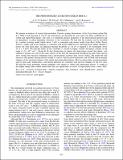THE PHOTOIONIZED ACCRETION DISK IN HER X-1
Author(s)
Ji, Li; Schulz, Norbert S.; Nowak, Michael A.; Kallman, T. R.; Marshall, Herman
DownloadJi-2009-THE PHOTOIONIZED ACC.pdf (653.4Kb)
PUBLISHER_POLICY
Publisher Policy
Article is made available in accordance with the publisher's policy and may be subject to US copyright law. Please refer to the publisher's site for terms of use.
Terms of use
Metadata
Show full item recordAbstract
We present an analysis of several high-resolution Chandra grating observations of the X-ray binary pulsar Her X-1. With a total exposure of 170 ks, the observations are separated by years and cover three combinations of orbital and superorbital phases. Our goal is to determine distinct properties of the photoionized emission and its dependence on phase-dependent variations of the continuum. We find that the continua can be described by a partial covering model which above 2 keV is consistent with recent results from Rossi X-Ray Timing Explorer studies and at low energies is consistent with recent XMM-Newton and BeppoSAX studies. Besides a power law with fixed index, an additional thermal blackbody of 114 eV is required to fit wavelengths above 12 Å (~1 keV). We find that likely all the variability is caused by highly variable absorption columns in the range (1-3) × 10[superscript 23] cm[superscript –2]. Strong Fe K line fluorescence in almost all observations reveals that dense, cool material is present not only in the outer regions of the disk but interspersed throughout the disk. Most spectra show strong line emission stemming from a photoionized accretion disk corona (ADC). We model the line emission with generic thermal plasma models as well as with the photoionization code XSTAR and investigate changes of the ionization balance with orbital and superorbital phases. Most accretion disk coronal properties such as disk radii, temperatures, and plasma densities are consistent with previous findings for the low state. We find that these properties change negligibly with respect to orbital and superorbital phases. A couple of the higher energy lines exhibit emissivities that are significantly in excess of expectations from a static ADC.
Date issued
2009-08Department
MIT Kavli Institute for Astrophysics and Space ResearchJournal
Astrophysical Journal
Publisher
Institute of Physics/American Astronomical Society
Citation
Ji, L., N. Schulz, M. Nowak, H. L. Marshall, and T. Kallman. “THE PHOTOIONIZED ACCRETION DISK IN HER X-1.” The Astrophysical Journal 700, no. 2 (July 7, 2009): 977–988. © 2009 American Astronomical Society.
Version: Final published version
ISSN
0004-637X
1538-4357